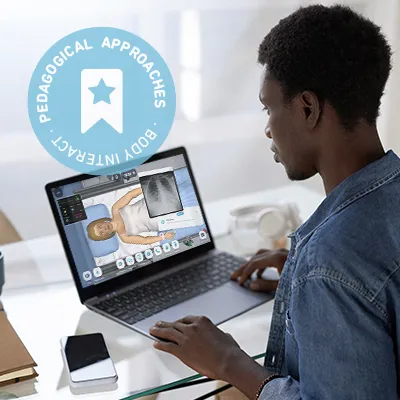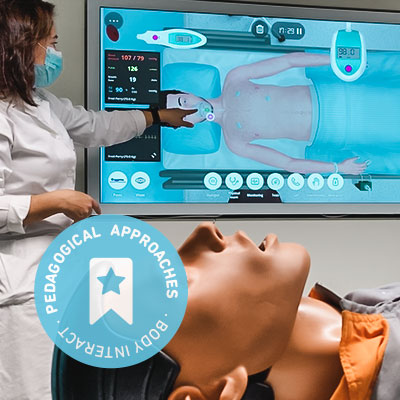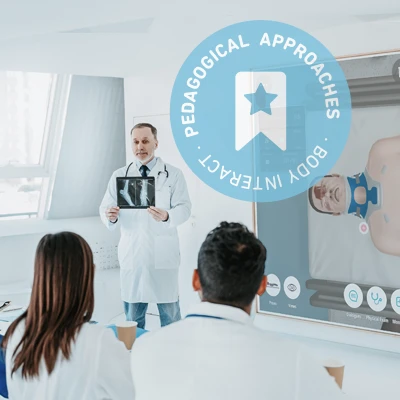Pedagogical Approaches with Body Interact | Team-Based Learning
The integration of Team-Based Learning (TBL) into clinical curricula has grown significantly in recent years. According to the literature, several key factors contribute to this trend: ‘administrators are pushing for classes to be larger…but want them to be taught in ways that are active, engaging, and promote positive learning outcomes…. accrediting bodies are also requiring documentation that schools are: (a) employing “active learning” … and (b) equipping students with the skills they will need to work in team-oriented environments.’ (Parmelle et all., 2012)
What is Team-Based Learning (TBL)?
Developed in the early 1990s, TBL is an active learning and small-group instructional strategy that provides students with opportunities to apply conceptual knowledge through a sequence of activities that includes individual work, teamwork, and immediate feedback. It can be used with large classes or smaller ones, always incorporating multiple small groups of 5-7 students each, in a single classroom.
Key Aspects of TBL – Step by Step
In terms of structure:
1. Pre-class preparation
Students study the assigned materials independently before class.
2. Readiness Assurance Tests
Individual (iRAT) and team-based (tRAT) quizzes to ensure comprehension.
3. Application exercises
Teams solve complex problems applying knowledge collaboratively.
4. Feedback and reflection
Immediate clarification of concepts by faculty.
In terms of faculty and student involvement
- Active learner engagement through pre-class preparation and interactive classes.
- Accountability at both the individual and team levels.
- Application-focused learning using real-life-like scenarios.
- Immediate feedback to enhance understanding and retention.
- Collaborative learning to develop essential teamwork skills.

How can Virtual Patients be integrated with TBL?
A possible approach to integrate Body Interact with TBL could be as follows:
TBL Stage
Integration with Body Interact
Pre-class preparation
Assign readings and resources relevant to the clinical conditions.
Assign a Body Interact scenario.
Define the groups.
iRAT
Conduct an online quiz covering relevant topics related to the scenario – diagnosis, treatment, and guidelines.
tRAT
Teams discuss and complete the same quiz together, building consensus and collaborative reasoning.
Application Exercise
Teams engage in the Virtual Patient scenario, delegating roles (communication, assessment, management).
Feedback and Reflection
Facilitate a structured debrief, reviewing the timeline, decisions, and performance feedback from Body Interact.
Peer Evaluation
Encourage teams to evaluate each other’s collaboration, leadership, and communication skills.
What are the benefits of integrating Body Interact Virtual Patients with TBL?
- Higher student motivation and engagement through realistic, interactive learning.
- Improved interpersonal, teamwork, and communication skills.
- Enhanced clinical reasoning by applying knowledge to realistic patient scenarios.
- Development of time management and prioritization skills under (simulated) pressure.
- Immediate and objective feedback from Body Interact, enriching team discussions.
- Safe environment to make mistakes and learn without patient harm.
Best Practices for Implementing TBL with Body Interact:
- Align scenarios with learning objectives for each TBL session.
- Design quizzes (iRAT/tRAT) that directly relate to the virtual patient scenario.
- Assign clear team roles during Body Interact sessions (example: team leader, interviewer, etc).
- Facilitate structured debriefing using Body Interact’s data (actions taken, time, metrics, outcomes).
- Encourage peer evaluation and self-reflection after simulations.
- Repeat key scenarios to reinforce learning and build confidence.
- Model initial sessions to demonstrate expectations and effective teamwork.
Who is using this instructional strategy?
If you would like to get to know how St. Luke’s Medical Center-College of Medicine, WHQM, is integrating Body Interact in TBL, explore the video where Dr. Athena Awayan-Lat presents this approach:
TBL shifts learning responsibility to students, fostering critical thinking and accountability within teams. If you are considering integrating this approach at your institution, take note of the best practices suggested and:
Conduct a pilot TBL with Body Interact in one module to evaluate feasibility and student response > Gather structured feedback from students and faculty > Adjust scenario selection, quizzes, and facilitation strategies based on evaluation data > Share results internally to advocate for broader integration across the curriculum.
Ready to Transform Your Teaching?
Want to know more about this pedagogical approach? Would you like to share your pedagogical approach with us?
References
1. Parmelee, D., Michaelsen, L. K., Cook, S., & Hudes, P. D. (2012). Team-based learning: A practical guide: AMEE Guide No. 65. Medical Teacher, 34(5), e275–e287. https://doi.org/10.3109/0142159X.2012.651179
2. Michaelsen, L. K., Parmelee, D. X., McMahon, K. K., & Levine, R. E. (2008). Team-Based Learning for Health Professions Education: A Guide to Using Small Groups for Improving Learning. Sterling, VA: Stylus Publishing.









